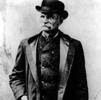The larger is the Tejon pass that includes many areas of historic value and some very dramatic driving conditions. The freeway is the latest of a series of highways and may have finally eliminated one of the most dangerous sections of highway in the nation. It was one of the first roads that had a cement center divider to make head on collections much less common. Parts of the road carried warnings that suggested turning off of air conditioners to prevent overheating of your car’s engine. You were traveling up a very steep grade in temperatures that could be over be 100° or it can be covered in snow depending on the time of the year. Some areas have become destinations for travel from Los Angeles. Los Angeles area children go to Frazer Park for their first time to play in the snow. Fort Tejon was the home to the camel caravan that was to be the way to carry supplies to military outposts in the wild west before the Civil War ended this project. Unfortunately, camels did not like walking on the very hard desert without the soft sand of the middle east. This spot welcomes tourists for reenactments of civil war battles. This is one of the best examples of a military outpost in California that was not changed to protect the area during later wars, as were the coastal forts, especially around the San Francisco Bay area. If you watch very carefully at the Castaic end of the route, you may realize that the road sections are reversed. Because of the grade situation it is safer to reverse the lanes. You are not physically next to each other and you have to look closely to see the other side of the road. It is most obvious when the roadways cross each other at the ends of the section. Luckily there are no cross roads in that area that could cause motorists to become confused.

The smaller pass is the one between the Santa Clarita valley and the San Fernando Valley. It is ignored most of the time, but contains some very important vistas. The most dramatic view may just be the hill that looks so nice, but in reality is what is left of a land fill. They have built up a valley to the point where they had to terrace the land to keep it from sliding. It resulted in a very large landscaped hill that overlooks the freeway. This section was closed in the last two major earthquakes when freeway ramps collapsed. Ask any long term resident how much fun that was, especially after an earthquake messed up travel anyway. On the other side of the freeway was to be the site of another land fill, until it was stopped by the people who live in the Santa Clarita Valley and especially in the city of Santa Clarita. It now is part of an open space area, that is being constantly added on to a preservation project. This will allow the people that follow us, see a part of what this area was before we all moved here. Yes you can still see wild animals in this area. Coyotes, deer, and wild animals of many sizes are still in the area. Taking a hike you must be aware of the wild life, especially in the summer when rattle snakes do roam the hills and valleys. As the area is made more accessible to the public, it will be more well known but may be ignored, so that the wild life can still have this area to themselves. It is an interesting place to drive and if you are there during one of the normal periods of congestion you will have plenty of time to check out the view. Besides you can see a Metrolink train going into the longest railroad tunnel in the western United States, down below the pass.
It is an interesting area and sometimes we are so into the travel that we miss these views.
The idea is to just enjoy the area where you are and don’t miss it all, in your haste.


No comments:
Post a Comment